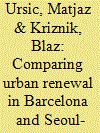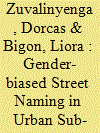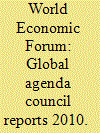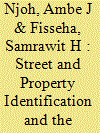| Srl | Item |
| 1 |
ID:
112463


|
|
|
|
|
| Publication |
2012.
|
| Summary/Abstract |
Cities have become increasingly autonomous economic and political actors which actively respond to the pressures and opportunities of globalisation. Consequently, the urban management of any particular city is often based on the assumption that the city can improve its position against rival cities by efficiently managing its strategic resources and promoting its presumed advantages. Though such an approach to urban management may help cities to improve their global competitiveness and the quality of their residents' everyday life, it can sometimes result in negative consequences at the local level, thus actually narrowing the development prospects of the cities in the end. This article discusses urban management against the backdrop of the competitive urban policy in Barcelona and Seoul, and compares the local consequences of urban renewal in both cities. Based on a comparison of the two cases of urban renewal, 22@ Activity District in Barcelona and the Cheonggyecheon restoration in Seoul, this article argues that, in conditions of competition among global cities, even very different approaches to urban management and urban renewal may result in similar consequences at the local level.
|
|
|
|
|
|
|
|
|
|
|
|
|
|
|
|
| 2 |
ID:
179111


|
|
|
|
|
| Summary/Abstract |
This article explores the present-day problematic of gender-biased street names as prevalent in sub-Saharan Africa’s cityscapes. That is, the abundance of masculine street names as opposed to feminine ones in the urban environments of this region. The article first provides a comparative view on the scope of this toponymic phenomenon in other geographic regions with relation to sub-Saharan Africa. It also identifies few decisive factors in the creation of the gender-biased urban landscapes in sub-Saharan Africa. These factors consist of: recent tendencies in critical toponymy studies; colonial and post-colonial cultures of governmentality; and inadequate urban planning legislation and vision as pertained by post-colonial states. This toponymic problematic is then exemplified in a site-specific analysis of the city of Bindura in north-eastern Zimbabwe. The article concludes with recommendations for designing a more socially inclusive urban management policy in the region, pointing to future research directions of this under-studied phenomenon in critical place-name studies.
|
|
|
|
|
|
|
|
|
|
|
|
|
|
|
|
| 3 |
ID:
103833


|
|
|
|
|
| Publication |
Geneva, World Economic Forum, 2010.
|
| Description |
358p.
|
|
|
|
|
|
|
|
|
|
|
|
Copies: C:1/I:0,R:0,Q:0
Circulation
| Accession# | Call# | Current Location | Status | Policy | Location |
| 055930 | 341.2322/WOR 055930 | Main | On Shelf | General | |
|
|
|
|
| 4 |
ID:
179103


|
|
|
|
|
| Summary/Abstract |
The study employs in-situ primary data supplemented with secondary information from conventional archival sources to examine the toponymic experience of Ethiopia, one of only two African countries without a colonial history. The focus is on Mekelle, the country’s third largest city. The city’s spatial structure is nondescript. The streets are identified with a string of numbers, which are placed at irregular intervals. Most landmarks are unnamed whereas buildings are unnumbered. This paper shows that the absence of a precise and unambiguous street, place and property identification system in the city stifles its performance in the urban management, economic, and social milieus.
|
|
|
|
|
|
|
|
|
|
|
|
|
|
|
|